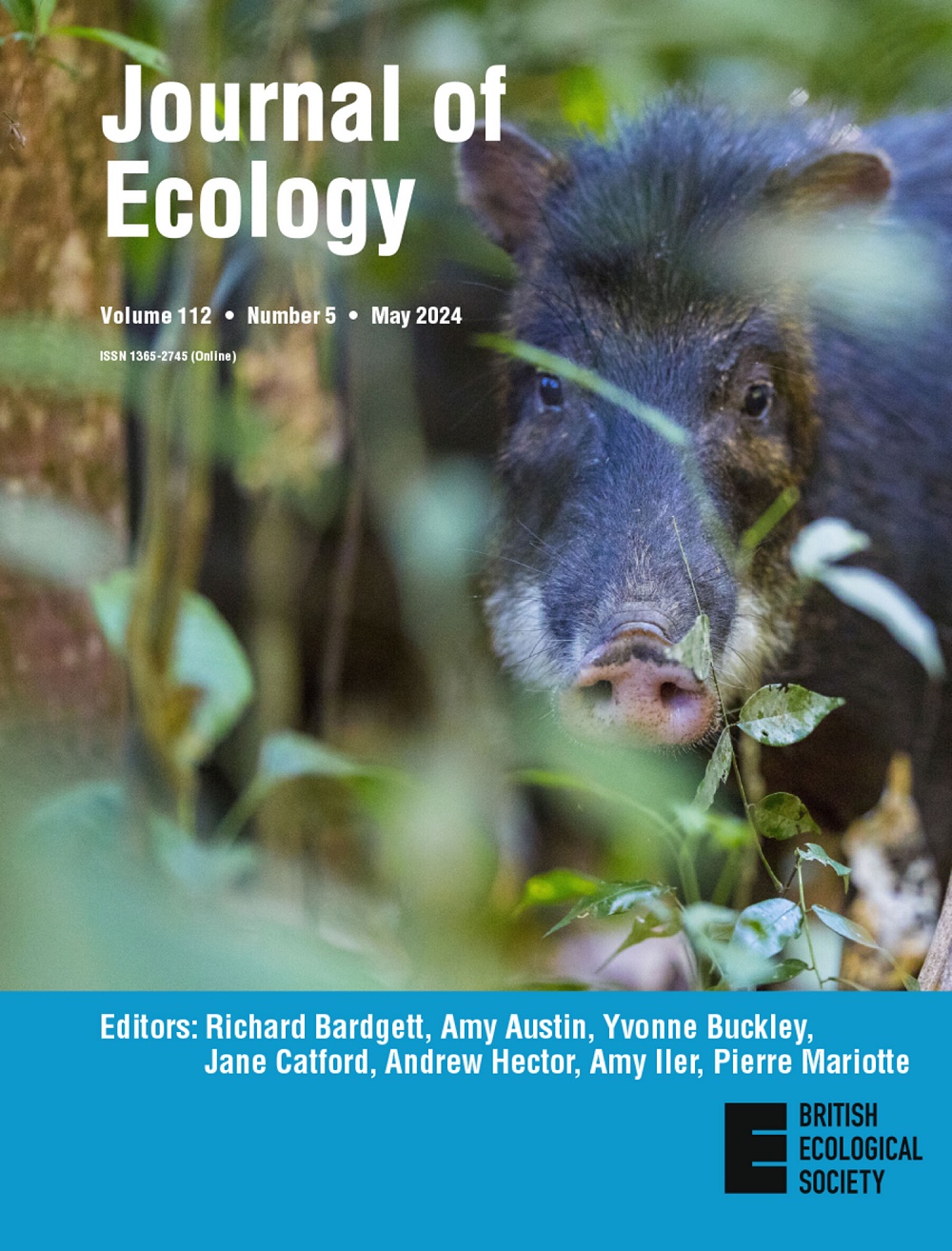Land-use changes impact root–fungal network connectivity in a global biodiversity hotspot
IF 5.6
1区 环境科学与生态学
Q1 ECOLOGY
引用次数: 0
Abstract


土地利用变化对全球生物多样性热点根真菌网络连通性的影响
热带雨林是高度多样化的生态系统,包含广泛的微栖息地和生物(Eiserhardt et al., 2017;Wardle et al., 2004)。然而,雨林面临着重大威胁,因为它们被油棕和橡胶等经济作物种植园迅速取代(Rembold等人,2017;Zemp et al., 2023)。例如,持续的农业扩张已导致全球约2100万公顷的油棕种植园(Descals等人,2021;Tedersoo et al., 2014)。总体而言,由于土地利用变化,本地物种的分类多样性下降(Ballauff et al., 2021;Barnes et al., 2017;Brinkmann等人,2019;Felipe-Lucia et al., 2020;Newbold et al., 2016)。然而,为了更好地理解农业扩张对热带生态系统的多重影响,我们迫切需要加强对土地利用转换对物种相互作用影响的认识(Brinkmann et al., 2019;Felipe-Lucia et al., 2020;Newbold et al., 2016;Romdhane et al., 2022)。植物-真菌关联在塑造热带生态系统的结构和功能方面发挥着重要作用(Põlme等人,2018;Tedersoo et al., 2014,2022),提供了对森林生态系统恢复力、适应能力和健康的见解(Trivedi et al., 2020)。涉及不同王国和功能行会的根-微生物相互作用(Brunel et al., 2020;Ferlian et al., 2018;麦克拉伦,卡拉汉,2020;Trivedi et al., 2020;Vorburger,Perlman, 2018)与互惠偏好、宿主之间的进化和性状差异以及真菌之间的系统发育相关性和竞争排斥有关(Alzarhani等人,2019;Francioli et al., 2021)。例如,丛枝菌根真菌(AMF)的丰度和多样性已被发现对植物多样性和组成的变化有响应(Deyn等,2011;Gui et al., 2017),宿主- amf偏好可能由植物功能群调节,而不是反映单个物种的相互作用(Edy et al., 2022;Francioli et al., 2021;Zanne et al., 2020)。此外,根际AMF丰度的增加预计会促进病原体丰度的降低(Francioli等人,2021;Sweeney et al., 2021;Zanne et al., 2020),并与腐养真菌丰度呈正相关(Francioli et al., 2021;范德海登&;哈特曼,2016)。虽然在热带低地森林中,大多数树种与AMF有关,但已知双龙心科和壳斗科的植物物种含有外生菌根真菌(EMF;Bahram et al., 2014;Matchado et al., 2021)。尽管如此,我们对低地热带雨林根-真菌关联的理解主要来自于对根- amf的研究(Gui等,2017;Koorem等人,2017),EMF研究主要来自温带生态系统(Encinas-Viso等人,2016;Hogan等人,2023;Kuang et al., 2021;Van Geel et al., 2018)。热带雨林向单一栽培的大规模转变减少了微生境多样性,导致物种更替(Ballauff et al., 2021;Barnes et al., 2017;Brinkmann et al., 2019)以及植物和真菌多样性的丧失(Barnes et al., 2017)。例如,在分析单个根样品中特定物种的根- AMF关联时,与热带雨林中取样的植物根相比,油棕和橡胶根中的AMF丰富度显著降低(Edy等人,2022)。与森林转化相关的环境过滤器可以选择耐受性和机会性的物种(植物和真菌),这些物种可以占据较大的生态位范围,并在转化景观中胜过本地物种(Gioria等人,2023;休姆,2017;麦克拉伦,卡拉汉,2020;Nayanakantha, 2007;维拉港和维纳,2004;Walther et al., 2009),导致群落组成的变化。因此,迫切需要了解自然和人为修改的生态系统中社区层面的相互作用(Chen et al., 2021;Delavaux et al., 2017;Sepp et al., 2019),但对热带多样性热点地区地下关联的研究很少。通过将来自相同样品的DNA扩增子测序与网络分析相结合,用于植物和真菌群落的评估,我们可以为生物群落中不同王国物种共存的机制提供有价值的见解,揭示特定环境条件下的营养和非营养相互作用(Grass等,2020;Montoya-Sánchez等,2023;Tiede et al., 2016;Zemp et al., 2023)。网络分析在识别高度连接的节点、促进关键物种的识别和形成群落结构所必需的相互作用方面起着至关重要的作用(guimer<e:1> &;阿马拉尔,2005;Põlme等人,2018;范德海登&;哈特曼,2016)。确定特定土地用途物种(例如: 指示物种)是指标值指数(IndVal)的使用,该指数评估与相关分类群最匹配的分布模式(De Cáceres et al., 2010),确定物种是特定于特定土地利用还是与多种土地利用类型相关。本文利用印度尼西亚苏门答腊岛四种土地利用类型的根和真菌群落的热带数据集,旨在了解热带雨林改造对全球热带生物多样性热点地区根-真菌网络组成和结构的影响。为了做到这一点,我们首先确定了根真菌群落的模式,并估计了与每种土地利用类型相关的指标物种。其次,我们通过共现网络分析估计根与真菌的关联。第三,我们研究了影响生态网络组成和结构的高度联系的分类群。我们假设森林转化是根-真菌关联的主要驱动因素,通过改变根的多样性、组成和性状(Ballauff et al., 2021)。例如,人工林的植物种类比热带雨林少59%,而后者主要由包括森林专家在内的本地物种组成,而其他土地利用类型的非本地物种丰富度和丰度更高(Rembold等,2017)。因此,我们期望雨林样地与稀有和特有物种的根相关联。相比之下,来自非本地和通用物种的根,以及适应在高度干扰的生态位中承受或茁壮成长的真菌群,由于它们对不利条件的适应能力,可以作为土地利用强度的指标。最后,在不同的土地利用类型中,我们假设与雨林相关的分类群比人工林中的分类群具有更大的生态连通性,从而有助于形成更结构化的生态系统。
本文章由计算机程序翻译,如有差异,请以英文原文为准。
求助全文
约1分钟内获得全文
求助全文
来源期刊

Journal of Ecology
环境科学-生态学
CiteScore
10.90
自引率
5.50%
发文量
207
审稿时长
3.0 months
期刊介绍:
Journal of Ecology publishes original research papers on all aspects of the ecology of plants (including algae), in both aquatic and terrestrial ecosystems. We do not publish papers concerned solely with cultivated plants and agricultural ecosystems. Studies of plant communities, populations or individual species are accepted, as well as studies of the interactions between plants and animals, fungi or bacteria, providing they focus on the ecology of the plants.
We aim to bring important work using any ecological approach (including molecular techniques) to a wide international audience and therefore only publish papers with strong and ecological messages that advance our understanding of ecological principles.
 求助内容:
求助内容: 应助结果提醒方式:
应助结果提醒方式:


